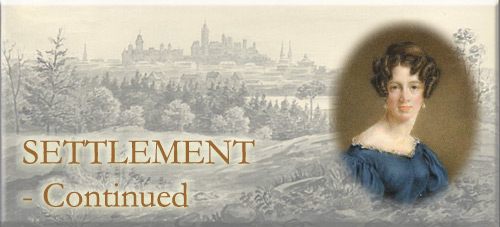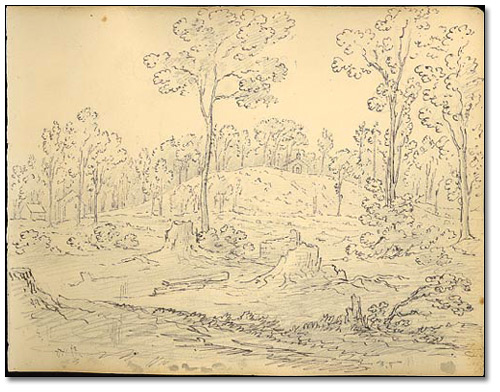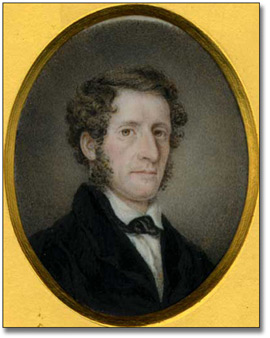
Table of Contents
Home | The Early Years | The Grand Tour | The Grand Tour- Continued
Britain - 1821-1837 | Miniatures on Ivory | Emigration - 1837
Settlement - 1837-1852 | Settlement - Continued | Peterborough and Toronto - 1852-1859
Britain & Canada: Tours and Vacations - 1860-1864 | Britain & Canada -1865-1878
Niagara, Ottawa, and Toronto - 1870s, 1880s
The Final Years | Langton Family and Family Connections | Preserving of the Collection
Resources and Acknowledgements
In her sketching, in and around Blythe Farm, Langton chose to record genuine "backwoods" scenes, with minimal embellishment, and scant artistic licence. The lack (by European aesthetic standards) of "rustic" features, picturesque ruins, "beautiful" vistas, precluded romanticizing the scenes. Nevertheless, Langton faced artistic conflict: how was she to depict this landscape without, on one hand, seeming overcritical of her new home - and without compromising her well-developed, artistic skills? She pragmatically adopted new aesthetic criteria, explored new subject matter: simple log cabins, snake fences, the surrounding wilderness. |
||
|
||
Langton selects a low viewpoint for this subject. The church, barely visible atop the hill, is a small, distant structure overshadowed by the seemingly endless, encroaching wilderness. |
||
Throughout her years on Sturgeon Lake, in addition to running the household, helping on the farm, and creating her visual and written descriptions of her surroundings, Langton served her community in many capacities: she was the first person to give lessons to local children, established the first "lending library," acted as "apothecary" and "nurse", provided charity to less fortunate families and worked for the church. She also occasionally turned again to painting of miniatures on ivory. |
||
Click to see a larger image (60K) [Anne Langton self portrait], 1840 Anne Langton Watercolour on ivory Reference Code: F 1077-7-1-0-17 Archives of Ontario, I0008574 |
This miniature is another of two self-portraits included in the recent Garland donation. On 24 June, 1840, her thirty-sixth birthday, Langton commented: "I ... get on very fast towards the awful age of forty!" (LR, 224). At this point - rather than four years later, to mark her "awful" fortieth birthday - she paints her last known self-portrait. Earlier, she had written, tellingly: "There is so much happiness, under every disadvantage, in having an object in life, and feeling yourself of real use to some one ... (GUC, 75). Now, as an "older," hearing-impaired gentlewoman, with an aging family to care for, Langton's prospects of marriage are almost non-existent; concerns about her future are beginning to surface. |
|
|
||
|
|
|
|
The two portraits above, painted in the year that John and Lydia married, were possibly the last two portraits that Anne Langton painted. Langton's talent as a miniaturist is now at its height, yet, ironically, the fine artist is about to be superseded by the photographer and the photographic process as preferred recorder of people and events. |
||
The year 1846, following the marriage of John and Lydia, was one of anguish for family and community. The annual summer scourge of ague, a type of malarial fever, struck with particular virulence. Anne, very ill herself, nursed her mother Ellen and her aunt Alice, who died within six weeks of each other. Many neighbours also died. Lydia's and John's first child died at two weeks of age. In 1847, the remaining Langtons made a visit to England; John and Lydia stayed for three weeks; Anne, for three years. William's residence became her home base. She was at a crucial turning-point. Not wishing to "fritter" her life away, she considered accepting an offer of a teaching position at a boarding School for Young Ladies, run by her friend, Miss Eliza Lowe, near London. Her preference, however, was to return to Canada. She eagerly accepted an invitation from John and Lydia to live with them, help raise their growing family and assist in running the household. Returning to Canada in 1850, Langton happily resumed her life at Blythe. Young Ellen and Thomas were joined by a brother, Harry, in 1851. Now assured of a permanent home, Langton found her place as the beloved sister and aunt in a warm family circle, thus fulfilling her wish "to be of real use to someone." |
||
|
|
||
|
Her art work seems to have lain fallow for a year or two, most likely because of domestic preoccupations. The above sketch shows Blythe Farm in its mature setting. Years of painstaking work have transformed the property into an aesthetic oasis. Ironically, the Langtons are about to depart "Blythe-in-the-backwoods" - forever. |
||
The Early Years | The Grand Tour | The Grand Tour- Continued
Britain - 1821-1837 | Miniatures on Ivory | Emigration - 1837
Settlement - 1837-1852 | Settlement - Continued | Peterborough and Toronto - 1852-1859
Britain & Canada: Tours and Vacations - 1860-1864 | Britain & Canada -1865-1878
Niagara, Ottawa, and Toronto - 1870s, 1880s
The Final Years | Langton Family and Family Connections | Preserving of the Collection
Resources and Acknowledgements

![[Anne Langton self portrait], 1840](pics/8574_anne_self_portrait.jpg)
![Mrs. John Langton [née Dunsford], 1845](pics/8567_lydia.jpg)

![Blythe farm, Ontario, [ca. 1851]](pics/8417_blythe_farm.jpg)